Evaluation of the Role of leadership style for the performances of employees at HSBC bank in Sri Lanka
Develop a critical review of relevant literature, refine aims and objectives, and devise a data collection strategy for a project in the field of business management.
77 Pages16873 Words478 Views
Added on 2023-04-08
About This Document
This research examines the impact of leadership styles on the performance of employees at HSBC bank in Sri Lanka. It evaluates the most effective leadership style and explores the implications of the contingency theory. Recommendations are provided to improve leadership capabilities.
Evaluation of the Role of leadership style for the performances of employees at HSBC bank in Sri Lanka
Develop a critical review of relevant literature, refine aims and objectives, and devise a data collection strategy for a project in the field of business management.
Added on 2023-04-08
ShareRelated Documents
Running head: RESEARCH PAPER
MASTER OF BUSINESS ADMINISTRATION DISSERTATION SESSION 2018/9
TITLE
Evaluation of the Role of leadership style for the performances of employees at HSBC
bank in Sri Lanka.
AUTHOR
Dilan Dharmaratne 420296632
MASTER OF BUSINESS ADMINISTRATION DISSERTATION SESSION 2018/9
TITLE
Evaluation of the Role of leadership style for the performances of employees at HSBC
bank in Sri Lanka.
AUTHOR
Dilan Dharmaratne 420296632
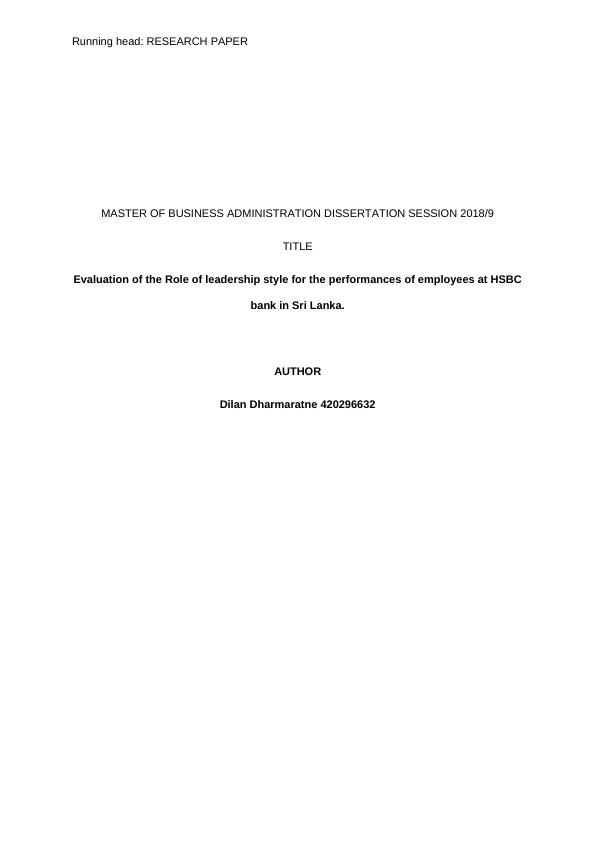
1RESEARCH PAPER
MBA Project Declaration
I declare that the work contained in this project has not been submitted for any other
award and that it is all my own work. To the best of my knowledge, the work contains
no material previously published or written by another person except where due
reference is made in the text of the project.
Title of project:
Effect of Role of leadership style for the performances of employees at HSBC bank in
Sri Lanka.
Name (Print): Dilan Dharmaratne
Signature: ______________________________________________
Date: 14th December 2018
MBA Project Declaration
I declare that the work contained in this project has not been submitted for any other
award and that it is all my own work. To the best of my knowledge, the work contains
no material previously published or written by another person except where due
reference is made in the text of the project.
Title of project:
Effect of Role of leadership style for the performances of employees at HSBC bank in
Sri Lanka.
Name (Print): Dilan Dharmaratne
Signature: ______________________________________________
Date: 14th December 2018
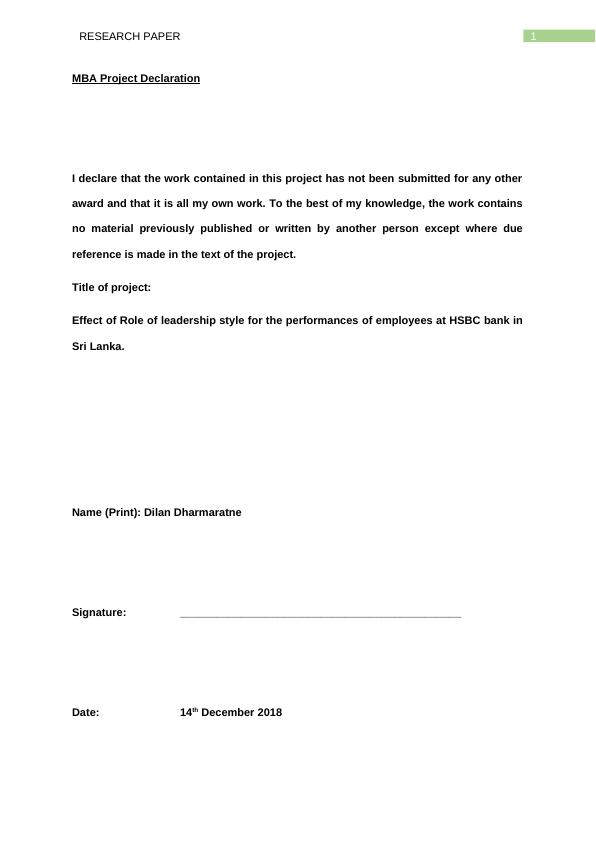
2RESEARCH PAPER
Table of Contents
Acknowledgement.................................................................................................................. 4
Abstract.................................................................................................................................. 5
Chapter 1: Introduction...........................................................................................................6
1.0 Introduction...................................................................................................................... 6
1.1 Background of the study...................................................................................................6
1.2 Research Problem............................................................................................................7
1.3 Rationale.......................................................................................................................... 8
1.4 Objective of the research..................................................................................................8
1.5 Research Question...........................................................................................................8
1.6 Research Hypothesis.......................................................................................................9
1.7 Structure of the dissertation..............................................................................................9
1.8 Summary........................................................................................................................ 10
Chapter 2: Literature review.................................................................................................12
2.1 Introduction..................................................................................................................... 12
2.2 Leadership..................................................................................................................... 12
2.3 Theories on leadership and leadership styles.................................................................13
2.3.1 Trait Approaches.........................................................................................................13
2.3.2 Behavioural Approaches.............................................................................................14
2.3.3 Contingency Theories..................................................................................................14
2.3.4 Situational Theories.....................................................................................................15
2.3.5 Transformational leadership........................................................................................16
2.3.6 Transactional leadership.............................................................................................18
2.4 Employee performance..................................................................................................20
2.5 Conceptual Framework..................................................................................................21
2.6 Literature gap................................................................................................................. 22
2.7 Summary........................................................................................................................ 22
Chapter 3: Research Methodology.......................................................................................23
3.1 Introduction..................................................................................................................... 23
Table of Contents
Acknowledgement.................................................................................................................. 4
Abstract.................................................................................................................................. 5
Chapter 1: Introduction...........................................................................................................6
1.0 Introduction...................................................................................................................... 6
1.1 Background of the study...................................................................................................6
1.2 Research Problem............................................................................................................7
1.3 Rationale.......................................................................................................................... 8
1.4 Objective of the research..................................................................................................8
1.5 Research Question...........................................................................................................8
1.6 Research Hypothesis.......................................................................................................9
1.7 Structure of the dissertation..............................................................................................9
1.8 Summary........................................................................................................................ 10
Chapter 2: Literature review.................................................................................................12
2.1 Introduction..................................................................................................................... 12
2.2 Leadership..................................................................................................................... 12
2.3 Theories on leadership and leadership styles.................................................................13
2.3.1 Trait Approaches.........................................................................................................13
2.3.2 Behavioural Approaches.............................................................................................14
2.3.3 Contingency Theories..................................................................................................14
2.3.4 Situational Theories.....................................................................................................15
2.3.5 Transformational leadership........................................................................................16
2.3.6 Transactional leadership.............................................................................................18
2.4 Employee performance..................................................................................................20
2.5 Conceptual Framework..................................................................................................21
2.6 Literature gap................................................................................................................. 22
2.7 Summary........................................................................................................................ 22
Chapter 3: Research Methodology.......................................................................................23
3.1 Introduction..................................................................................................................... 23

3RESEARCH PAPER
3.2 Research Philosophy......................................................................................................23
3.3 Research Approach........................................................................................................24
3.4 Research Design............................................................................................................ 24
3.5 Data collection and analysis...........................................................................................25
3.6 Sampling technique........................................................................................................26
3.7 Reliability and validity.....................................................................................................26
3.8 Ethical consideration......................................................................................................27
3.9 Summary........................................................................................................................ 27
Chapter 4: Findings and Analysis.........................................................................................28
4.1 Introduction..................................................................................................................... 28
4.2 Reliability and Validity testing.........................................................................................28
4.3 Demographic questions..................................................................................................31
4.4 Questions on Transformational leadership.....................................................................34
4.5 Questions on Transactional leadership...........................................................................41
4.6 Questions contingency theory of leadership...................................................................46
4.7 Questions on employee performance.............................................................................49
4.7 Correlation Analysis........................................................................................................52
4.8 Regression Analysis.......................................................................................................58
4.9 Discussion...................................................................................................................... 64
4.10 Summary...................................................................................................................... 64
Chapter 5: Conclusion..........................................................................................................65
5.1 Introduction..................................................................................................................... 65
5.2 Conclusion...................................................................................................................... 65
5.3 Recommendation........................................................................................................... 66
5.4 Self reflection.................................................................................................................. 66
5.5 future scope.................................................................................................................... 67
References........................................................................................................................... 68
Appendix.............................................................................................................................. 72
3.2 Research Philosophy......................................................................................................23
3.3 Research Approach........................................................................................................24
3.4 Research Design............................................................................................................ 24
3.5 Data collection and analysis...........................................................................................25
3.6 Sampling technique........................................................................................................26
3.7 Reliability and validity.....................................................................................................26
3.8 Ethical consideration......................................................................................................27
3.9 Summary........................................................................................................................ 27
Chapter 4: Findings and Analysis.........................................................................................28
4.1 Introduction..................................................................................................................... 28
4.2 Reliability and Validity testing.........................................................................................28
4.3 Demographic questions..................................................................................................31
4.4 Questions on Transformational leadership.....................................................................34
4.5 Questions on Transactional leadership...........................................................................41
4.6 Questions contingency theory of leadership...................................................................46
4.7 Questions on employee performance.............................................................................49
4.7 Correlation Analysis........................................................................................................52
4.8 Regression Analysis.......................................................................................................58
4.9 Discussion...................................................................................................................... 64
4.10 Summary...................................................................................................................... 64
Chapter 5: Conclusion..........................................................................................................65
5.1 Introduction..................................................................................................................... 65
5.2 Conclusion...................................................................................................................... 65
5.3 Recommendation........................................................................................................... 66
5.4 Self reflection.................................................................................................................. 66
5.5 future scope.................................................................................................................... 67
References........................................................................................................................... 68
Appendix.............................................................................................................................. 72
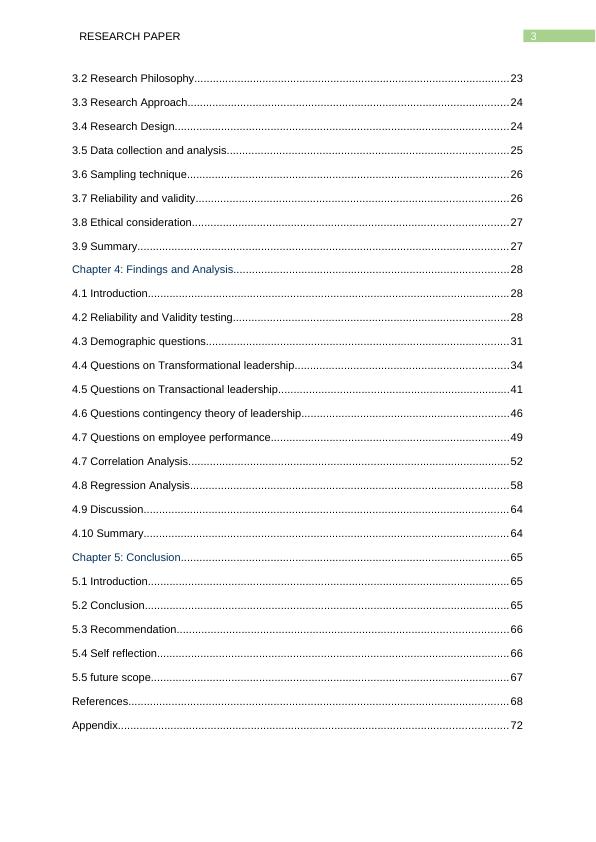
4RESEARCH PAPER
ACKNOWLEDGEMENT
I also would like to extend my sincere thanks to the academic and administrative staff at
BMS institute Colombo and the Edinburgh Napier university for the support given to me in
completing this task, who shared their knowledge and assisted me in many ways to achieve
my academic success in completing this MBA.
My special thanks are due to the participants who spend their valuable time in completing
the questionnaire.
ACKNOWLEDGEMENT
I also would like to extend my sincere thanks to the academic and administrative staff at
BMS institute Colombo and the Edinburgh Napier university for the support given to me in
completing this task, who shared their knowledge and assisted me in many ways to achieve
my academic success in completing this MBA.
My special thanks are due to the participants who spend their valuable time in completing
the questionnaire.

5RESEARCH PAPER
ABSTRACT
This research had examined the impact of leadership styles on the performance of the
employees. HSBC SriLanka was chosen as the case study for the research. Leadership is a
key aspect of modern business as it assists the workforce in striving towards their personal
and professional goals. The analysis of the past literature had shown that there had been
significant contribution in the field of leadership and employee performance. However, very
few literature that had evaluated which of the leadership styles are more effective in modern
organizational context. The research had used a single research design which used the
positivist view and conducted quantitative data to examine the impact of leadership on the
performance of the employees. The findings show that transformational leadership was the
most effective as per the research problem in HSBC. The research had provided relevant
conclusion and recommendation based on the results.
ABSTRACT
This research had examined the impact of leadership styles on the performance of the
employees. HSBC SriLanka was chosen as the case study for the research. Leadership is a
key aspect of modern business as it assists the workforce in striving towards their personal
and professional goals. The analysis of the past literature had shown that there had been
significant contribution in the field of leadership and employee performance. However, very
few literature that had evaluated which of the leadership styles are more effective in modern
organizational context. The research had used a single research design which used the
positivist view and conducted quantitative data to examine the impact of leadership on the
performance of the employees. The findings show that transformational leadership was the
most effective as per the research problem in HSBC. The research had provided relevant
conclusion and recommendation based on the results.

6RESEARCH PAPER
CHAPTER 1: INTRODUCTION
1.0 INTRODUCTION
This research has aimed to examine the impact of leadership styles on the
performance of the employees. HSBC SriLanka has been chosen as the case study for the
research. Leadership is a key aspect of modern business as it assists the workforce in
striving towards their personal and professional goals. It also generates an organizational
culture that is conducive for improving the productivity and team work of employees. Khoza,
Chetty and Karodia (2016) stated that effective leadership can promote excellent
development for the employees within the organization. The theoretical perspective
presented by Fred Fiedler highlighted the contingency model theory of leadership that
proposed that effectiveness of the employee performance depends on ability of the leader to
lead is contingent on situational factor (Matthews, Daigle & Houston, 2018). These factors
include preferred style, behavior, capabilities and competency of the employees. This
signifies that leaders should adapt to the styles that is best to a current situation and use
different styles to stimulate the performance of the employees. However, there has been
arguments in the past literature over the appropriate style of leadership to motivate the
employees and enhance their performance. This research has aimed to highlight the
leadership style which is most significantly effective for improving the performance of the
employees or whether the contingency theory holds true in the context of HSBC SriLanka.
1.1 BACKGROUND OF THE STUDY
Leadership has been understood as the method of explanation and persuasion along
with the ability to classify, confirm and reintroduce the values of the groups represented by
the leader. Leadership is not bounded by virtues technical skills, managerial expertise,
cultural literacy and other skills (Khoza, Chetty & Karodia, 2016). Effective leaders have the
duty to guide the workforce by sharing knowledge so that they achieve highest quality of
performance. Business entities have been trying to hire the best possible leaders for their
respective organizations. Moreover, past researches show that various researches have
been conducted to understand the ways great leaders operate. This has resulted in the
development of various leadership theories. The significance of leadership styles is known
from the past researches as various investigations has been performed in developing and
developed countries. This research has considered the case of HSBC to understand the
suitable leadership style for the employees within the organization.
HSBC is one of the most renowned international brands and considered one of the
market leaders in the global banking industry. The company is one of the largest operating in
CHAPTER 1: INTRODUCTION
1.0 INTRODUCTION
This research has aimed to examine the impact of leadership styles on the
performance of the employees. HSBC SriLanka has been chosen as the case study for the
research. Leadership is a key aspect of modern business as it assists the workforce in
striving towards their personal and professional goals. It also generates an organizational
culture that is conducive for improving the productivity and team work of employees. Khoza,
Chetty and Karodia (2016) stated that effective leadership can promote excellent
development for the employees within the organization. The theoretical perspective
presented by Fred Fiedler highlighted the contingency model theory of leadership that
proposed that effectiveness of the employee performance depends on ability of the leader to
lead is contingent on situational factor (Matthews, Daigle & Houston, 2018). These factors
include preferred style, behavior, capabilities and competency of the employees. This
signifies that leaders should adapt to the styles that is best to a current situation and use
different styles to stimulate the performance of the employees. However, there has been
arguments in the past literature over the appropriate style of leadership to motivate the
employees and enhance their performance. This research has aimed to highlight the
leadership style which is most significantly effective for improving the performance of the
employees or whether the contingency theory holds true in the context of HSBC SriLanka.
1.1 BACKGROUND OF THE STUDY
Leadership has been understood as the method of explanation and persuasion along
with the ability to classify, confirm and reintroduce the values of the groups represented by
the leader. Leadership is not bounded by virtues technical skills, managerial expertise,
cultural literacy and other skills (Khoza, Chetty & Karodia, 2016). Effective leaders have the
duty to guide the workforce by sharing knowledge so that they achieve highest quality of
performance. Business entities have been trying to hire the best possible leaders for their
respective organizations. Moreover, past researches show that various researches have
been conducted to understand the ways great leaders operate. This has resulted in the
development of various leadership theories. The significance of leadership styles is known
from the past researches as various investigations has been performed in developing and
developed countries. This research has considered the case of HSBC to understand the
suitable leadership style for the employees within the organization.
HSBC is one of the most renowned international brands and considered one of the
market leaders in the global banking industry. The company is one of the largest operating in
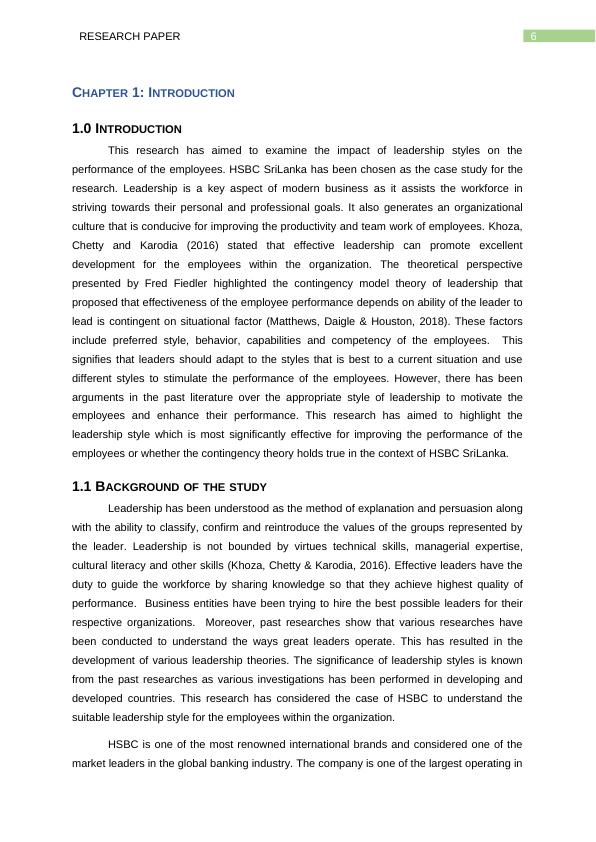
7RESEARCH PAPER
more than 60 countries all over the world (HSBC Sri Lanka, 2019). The company is providing
service to more than 38 million consumers all over the world through their 3900 branches all
across the globe (HSBC Sri Lanka, 2019). HSBC is one of the oldest banks in SriLanka and
has been awarded repeatedly in the past which highlights the performance they have
achieved over the decades. HSBC has been the first movers in the Sri Lankan market in
terms of various services offered to the consumer, such as digital banking (HSBC Sri Lanka,
2019). The company not provides commercial banking services but also personal banking
services consisting of individual and corporate consumers. The target consumers of the
bank are high end consumers having high net worth in the market. Therefore, in order to
maintain sustainable competitive advantage, the organization requires effective performance
levels from the workforce.
1.2 RESEARCH PROBLEM
The organization lost revenue in the year of 2017, when their revenue decreased to
5.275 billion rupees compared to the 5.598 billion rupees. HSBC continued to lose their
funds in the next year and the whole year was a setback for the company. This shows that
the company has failed to hold to their growth and sustain in the Sri Lankan market.
Workforce is one of the major sources of competitive advantage for the company and the
data clearly shows that there is deterioration in the performance of the employees. However,
this can only be confirmed by conducting an extensive study on the employees to
understand the impact of leadership on the loss of the company. Moreover, SriLanka is a
country with high power distance resulting in a hierarchical structure. Therefore, the research
has aimed to examine the leadership style at HSBC Sri Lanka to understand any
irregularities that may affect the performance of the employees and the company. The
company lost revenue at the global level which shows that there are in efficiencies which
needs to be taken care of. HSBC’s inability to grow while keeping their cost intact is one of
the major concerns for the investors and bank has been missing their target income more
frequently than before. The organization also reported expected loss in credit that is much
higher than the expected amount. Moreover, the company has been under the limelight for
the wrong reasons where they had to pay heavy fine due to tax related issues which is also
affecting their performance. Therefore, in this situation of crisis, the organization needs to
develop effective strategies to improve the performance level of the employees. The
research has examined the leadership style of the management in HSBC to understand the
contribution of leadership on the performance of the employees.
more than 60 countries all over the world (HSBC Sri Lanka, 2019). The company is providing
service to more than 38 million consumers all over the world through their 3900 branches all
across the globe (HSBC Sri Lanka, 2019). HSBC is one of the oldest banks in SriLanka and
has been awarded repeatedly in the past which highlights the performance they have
achieved over the decades. HSBC has been the first movers in the Sri Lankan market in
terms of various services offered to the consumer, such as digital banking (HSBC Sri Lanka,
2019). The company not provides commercial banking services but also personal banking
services consisting of individual and corporate consumers. The target consumers of the
bank are high end consumers having high net worth in the market. Therefore, in order to
maintain sustainable competitive advantage, the organization requires effective performance
levels from the workforce.
1.2 RESEARCH PROBLEM
The organization lost revenue in the year of 2017, when their revenue decreased to
5.275 billion rupees compared to the 5.598 billion rupees. HSBC continued to lose their
funds in the next year and the whole year was a setback for the company. This shows that
the company has failed to hold to their growth and sustain in the Sri Lankan market.
Workforce is one of the major sources of competitive advantage for the company and the
data clearly shows that there is deterioration in the performance of the employees. However,
this can only be confirmed by conducting an extensive study on the employees to
understand the impact of leadership on the loss of the company. Moreover, SriLanka is a
country with high power distance resulting in a hierarchical structure. Therefore, the research
has aimed to examine the leadership style at HSBC Sri Lanka to understand any
irregularities that may affect the performance of the employees and the company. The
company lost revenue at the global level which shows that there are in efficiencies which
needs to be taken care of. HSBC’s inability to grow while keeping their cost intact is one of
the major concerns for the investors and bank has been missing their target income more
frequently than before. The organization also reported expected loss in credit that is much
higher than the expected amount. Moreover, the company has been under the limelight for
the wrong reasons where they had to pay heavy fine due to tax related issues which is also
affecting their performance. Therefore, in this situation of crisis, the organization needs to
develop effective strategies to improve the performance level of the employees. The
research has examined the leadership style of the management in HSBC to understand the
contribution of leadership on the performance of the employees.
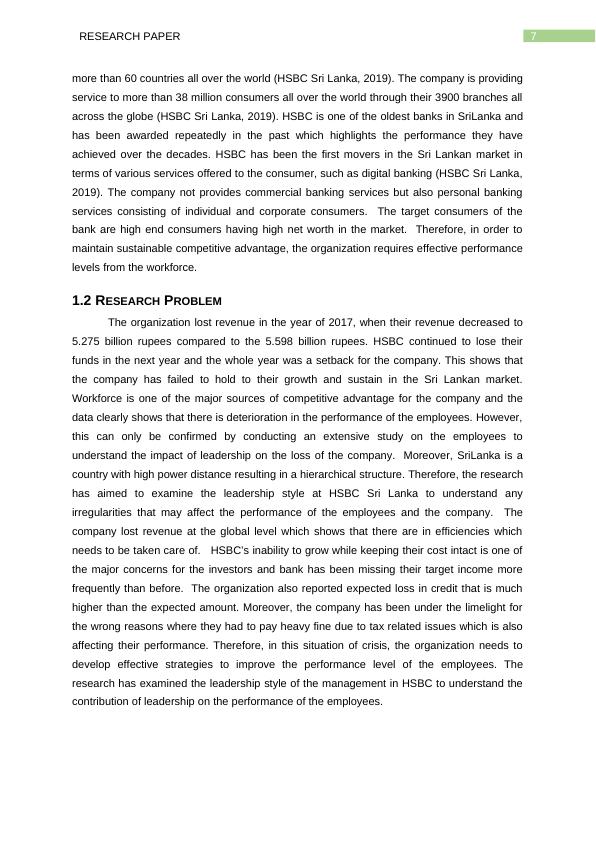
End of preview
Want to access all the pages? Upload your documents or become a member.
Related Documents
Impact of Leadership style on Employee Performance: A case study of HSBClg...
|87
|19011
|452
Impact of Leadership Style on Employee Performance in Airline Industrylg...
|79
|18298
|80
The Effect of Leadership on Employee Performancelg...
|42
|12225
|21
Decline in Publishing Industry of Sri Lankalg...
|39
|8517
|71
THE STUDY OF OCCUPATIONAL HEALTH AND SAFETYlg...
|62
|17685
|38
A study of leadership skills necessary for management of group conflicts at Tesco UKlg...
|78
|14269
|393
